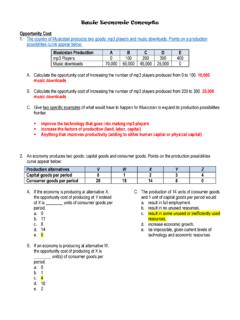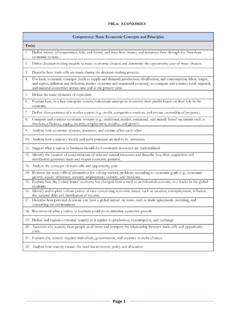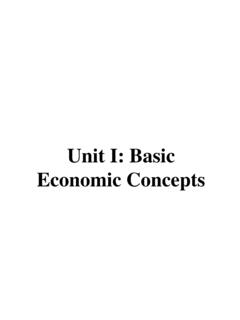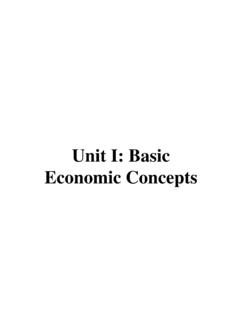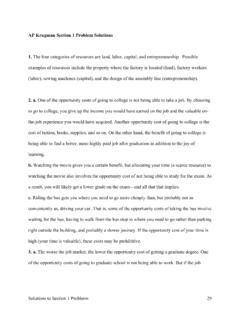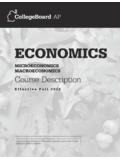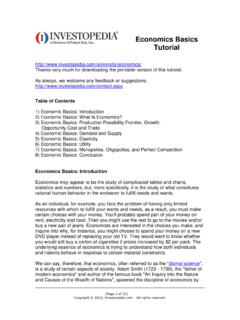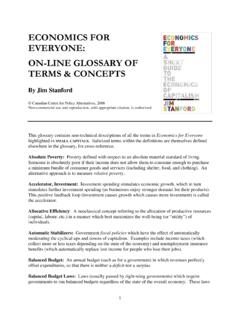Transcription of Basic Economic Concepts - Online Campus
1 Basic Economic ConceptsModule 1: The Study of EconomicsModule 2: Introduction to MacroeconomicsModule 3: The Production Possibilities Curve ModelModule 4: Comparative Advantage and TradeAppendix: Graphs in EconomicsEconomics by Example: What s to Love About Economics?COMMON GROUNDThe annual meeting of the American Economic Association draws thousands of economists, young and old, famous and obscure. There are booksellers, business meetings, and quite a few job interviews. But mainly the economists gather to talk and listen. During the busiest times, 60 or more presentations may be taking place simultaneously, on questions that range from the future of the stock market to who does the cooking in two-earner do these people have in common?
2 An expert on the stock market probably knows very little about the economics of housework, and vice versa. Yet an economist who wanders into the wrong seminar and ends up listening to presentations on some unfamiliar topic is nonetheless likely to hear much that is familiar. The reason is that all Economic analysis is based on a set of common principles that apply to many different of these principles involve individual choice for economics is, first of all, about the choices that individuals make. Do you choose to work during the summer or take a backpacking trip? Do you buy a new CD or go to a movie?
3 These decisions involve making a choice from among a limited number of alternatives limited because no one can have everything that he or she wants. Every question in economics at its most Basic level involves individuals making to understand how an economy works, you need to understand more than how individuals make choices. None of us lives like Robinson Crusoe, alone on an island we must make decisions in an environment that is shaped by the decisions of others. Indeed, in our global economy even the simplest decisions you make say, what to have for breakfast are shaped by the decisions of thousands of other people, from the banana grower in Costa Rica who decided to grow the fruit you eat to the farmer in Iowa who provided the corn in your cornflakes.
4 And because each of us depends on so many others and they, in turn, depend on us our choices interact. So although all economics at a Basic level is about individual choice, in order to understand behavior within an economy we must also understand Economic interaction how my choices affect your choices, and vice important Economic interactions can be understood by looking at the markets for individual goods for example, the market for corn. But we mustPrinted Page 1[Notes/Highlighting] SECTION INTRODUCTION also understand economy-wide interactions in order to understand how they can lead to the ups and downs we see in the economy as a this section we discuss the study of economics and the difference between microeconomics and macroeconomics.
5 We also introduce the major topics within macroeconomics and the use of models to study the macroeconomy. Finally, we present the production possibilities curve model and use it to understand Basic Economic activity, including trade between two economies. Because the study of economics relies on graphical models, an appendix on the use of graphs follows the end of this section. Module 1: The study of Economics The study of Economics How scarcity and choice are central to the study of economics The importance of opportunity cost in individual choice and decision making The difference between positive economics and normative economics When economists agree and why they sometimes disagree What makes macroeconomics different from microeconomicsPrinted Page 2[Notes/Highlighting]Individual Choice: The Core of EconomicsEconomics is the study of scarcity and choice.
6 Every Economic issue involves, at its most Basic level, individual choice decisions by individuals about what to do and what not to do. In fact, you might say that it isn t economics if it isn t about into a big store such as Walmart or Target. There are thousands of different products available, and it is extremely unlikely that you or anyone else could afford to buy everything you might want to have. And anyway, there s only so much space in your room. Given the limitations on your budget and your living space, you must choose which products to buy and which to leave on the fact that those products are on the shelf in the first place involves choice the store manager chose to put them there, and the manufacturers of the products chose to produce them.
7 The economy is a system that coordinates choices about production with choices about consumption, and distributes goods and services to the people who want them. The United States has a market economy, in which production and consumption are the result of decentralized decisions by many firms and individuals. There is no central authority telling people what to produce or where to ship it. Each individual producer makes what he or she thinks will be most profitable, and each consumer buys what he or she alternative to a market economy is a command economy, in which industry is publicly owned and there is a central authority making production and consumption decisions.
8 Command economies have been tried, most notably in the Soviet Union between 1917 and 1991, but they didn t work very well. Producers in the Soviet Union routinely found themselves unable to produce because they did not have crucial raw materials, or they succeeded in producing but then found nobody wanted what the central authority had them produce. Consumers were often unable to find necessary items command economies are famous for long lines at the root of the problem with command economies is a lack of incentives, which are rewards or punishments that motivate particular choices.
9 In market economies, producers are free to charge higher prices when there is a shortage of something, and to keep the resulting profits. High prices and profits provide incentives for producers to make more of the most-needed goods and services and eliminate fact, economists tend to be skeptical of any attempt to change people s behavior that doesn t change their incentives. For example, a plan that calls on manufacturers to reduce pollution voluntarily probably won t be effective; a plan that gives them a financial incentive to do so is more likely to rights, which establish ownership and grant individuals the right to trade goods and services with each other, create many of the incentives in market economies.
10 With the right to own property comes the incentive to produce things of value, either to keep, or to trade for mutual gain. And ownership creates an incentive to put resources to their best possible use. Property rights to a lake, for example, give the owners an incentive not to pollute that lake if its use for recreation, serenity, or sale has greater any economy, the decisions of what to do with the next ton of pollution, the next hour of free time, and the next dollar of spending money are marginal decisions. They involve trade-offs at the margin: comparing the costs and benefits of doing a little bit more of an activity versus a little bitPrinted Page 2[Notes/Highlighting]
